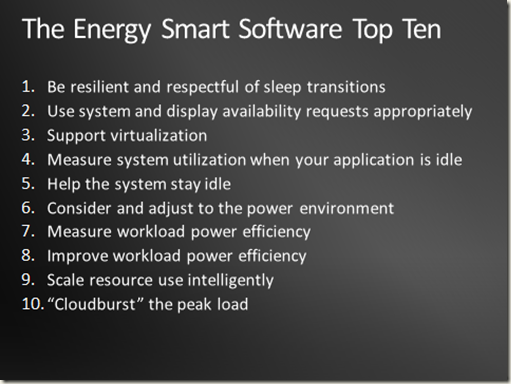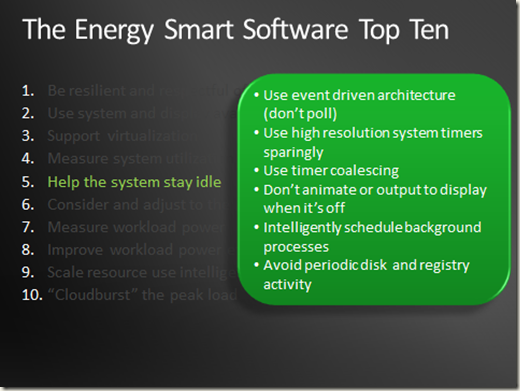The Efficiency Imperative
On Monday, I was proud to speak on behalf of Microsoft at Intel Developer Forum 2010 on the critical need for developers to do their part to help improve IT efficiency. IT efficiency is a component of Greener IT, which is the term Microsoft is using for recognizing that Green IT is a journey rather than a destination.
As I laid out in my presentation, IT efficiency has (or should) become the next critical focus for IT. Efficiency shares characteristics similar to security, in that everyone involved, including Business Decision Makers, developers, IT Pros, and even users, together with hardware and software vendors, need to do their part to improve IT efficiency.
Readers of my blog know that applications have been the missing link that prevents PCs and servers from being highly efficient. Now is the time to fill that void. With Windows 7 and Windows Server 2008 R2, IT Pros, developers and enthusiasts are able to use in-box diagnostic tools to determine why power management is not working as expected. Microsoft uses these tools every day to identify problems with its own and even third party applications, and we are asking the rest of the Windows ecosystem to do the same to ensure that their applications are “energy smart”.
So where should a developer start? During my talk, I unveiled the “Energy Smart Software Top 10”, which provides recommendations for how developers should prioritize their energy smart software efforts:
For developers of client software, steps 1 through 8 are relevant. For server developers 3-10 are relevant. Additionally, I outlined some of the key investments that will help keep systems idle.
We have published a collection of guidance on www.microsoft.com/energysmart that covers the majority of these recommendations to help developers build energy smart software. More guidance will be added over the coming weeks and months.
There are also links on the site to tools, including an update of the Joulemeter research project by Microsoft Research that we also announced at IDF. The new version of Joulemeter helps democratize computer power measurement by allowing laptop users to use their laptop battery to calibrate the power model to their specific machine.
Developers who have questions on developing energy smart applications can post questions in our MSDN forum.
While there are many factors that are forcing the need to focus on IT efficiency (e.g. increased demand for IT, power constraints, regulations and stakeholder pressure), there are a lot of benefits as well. Users can be more productive due to better power management experiences and TCO can be reduced through smaller energy bills and less idle equipment. And it won’t hurt that our planet’s life support systems will be just a little less stressed as we slow down the rate of extraction and waste disposal (including carbon into the atmosphere) as a result of more efficient IT utilization.
As I closed my presentation, I noted that Intel calculated that the world’s 1 billion PCs collectively consumed more than 320 terawatt hours of electricity in 2007. They estimate that by 2014, advances in computing will allow 2 billion PCs to consume less than half of that amount (151 twH), but provide more than 17 times the computing power.
This is certainly would be an impressive feat for energy-efficient performance, and one that I hope the industry can meet. But, as I pointed out, hardware and operating system advances alone will not get us there. Developers will need to take an active role and ensure their software is energy smart if we are to get close to achieving this goal.
Again, if you write software for a living, you owe it to yourself, your customers and the environment to become educated on energy smart software development. Please visit https://microsoft.com/energysmart today!
For those of you who couldn’t attend my talk, a recorded interview of me talking about the topic is available on MSDN’s channel 9. If and when we get the video from IDF, I’ll post a link to that too.

